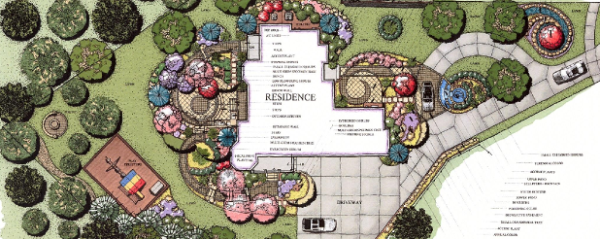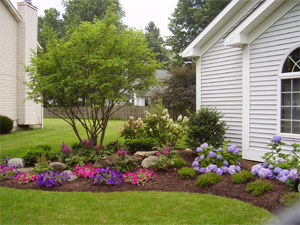
In Landscape Architecture, as well as other design professions, these elements are the foundation of good design.
LINE – Lines can be horizontal, vertical, diagonal or curved. Lines are used in landscape designs to accentuate an object, control movement or draw attention to a focal point such as a fire pit or water feature. A walkway or garden path with a direct route to a focal point will naturally draw a person to that area. In contrast, a walkway that meanders will create a feeling of surprise.
Lines can be real (actual) or perceived (implied). Perceived lines are created from a series of objects organized in such a fashion to make it seem as though a line is present. This can be seen in the backyard landscape design by using plant forms to imply a line.
 FORM – Forms are associated with three-dimensional objects. Plants come in many forms including round, upright, spreading, etc. A round plant following a curved bedline gives a landscape a flowing and natural feel. In contrast, an upright or columnar plant placed along a linear walk takes on a more rigid and formal feel.
FORM – Forms are associated with three-dimensional objects. Plants come in many forms including round, upright, spreading, etc. A round plant following a curved bedline gives a landscape a flowing and natural feel. In contrast, an upright or columnar plant placed along a linear walk takes on a more rigid and formal feel.
Landscsape plants may also change form when they are grouped together in a mass. When a design composition is viewed as a whole, the individual forms become subordinate to the overall mass of the composition.
COLOR – Color tends to be the most used (as well as over-used) element of landscape design composition. Warm colors include reds, yellows, and oranges. Cool colors include blues, greens and purples. Warm and cool color combinations have different visual impacts on the landscape. Color is an important design consideration for both plants and hardscape.
Both foliage and landscape flower color create moods. In landscape design, color is used for visual interest. Colors should be intricately weaved throughout the design composition and its presence must be extended across the seasons at various levels.
TEXTURE – Texture is a surface characteristic that can be divided into three categories: Coarse, Medium and Fine. Plants, pavements and other site elements all have their own texture. Contrasting textures add interest to a landscape and should play an important role in design composition.
Landscape plants and flowers possess a wide range of textural attributes, including leaf, flower shape and surface, bark and stems. All of these can greatly enrich the visual quality of a cleveland landscape composition.
Understanding these elements of design composition is an integral part of laying the foundation for good design and ensuring you will love your landscaping for years. If you would like assistance in planning your landscape design you should talk to a professional landscape designer or contractor.


